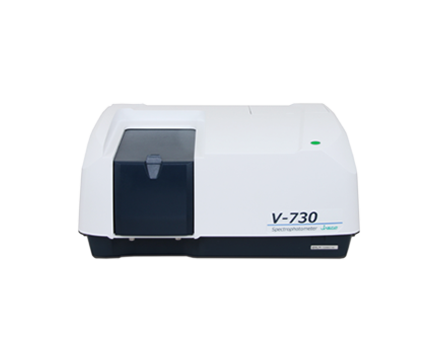Haze Measurement using a UV-Visible Spectrophotometer
January 5, 2024
Introduction
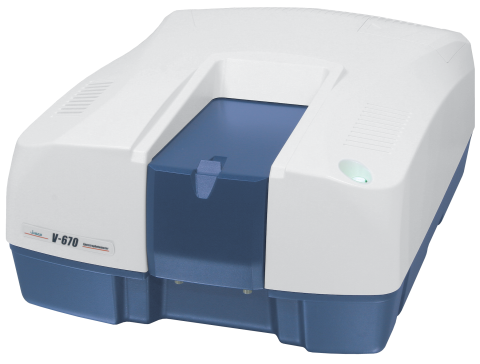
UV-Vis Spectrophotometer
The haze measurement of a transparent sample describes the amount of light scattered when light passes through a transparent sample. The lower the haze measurement value, the higher the clarity of the sample indicating fewer impurities.
In this application note, the haze measurement value and total light transmittance in a sample of diffuser panels is reported, using measurement methods based on JIS, ISO, and ASTM standard procedures.
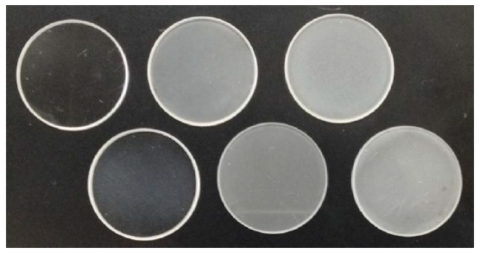
Experimental
Figure 1 illustrates how the total transmittance (Tt), sample diffusion rate (T4), and scattering rate (T3) are obtained using an integrating sphere. The baseline spectrum is obtained using a white diffuse reference plate (1) and the light scattered by the instrument itself is measured (T3) in order to calibrate the spectrophotometer.
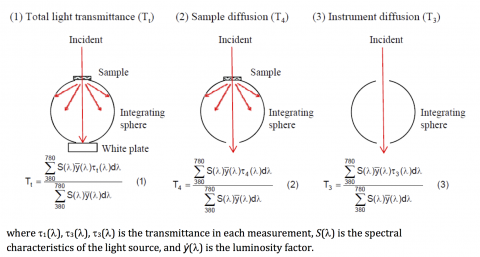
The total light transmittance and sample diffusion of the sample is then measured and the haze value is calculated by the ratio of the two spectra:
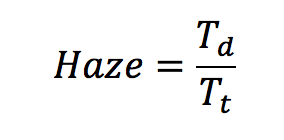
| Measurement Conditions | |||
| Bandwidth | 5 nm | Scan Speed | 400 nm/min |
| Response | 0.24 sec | Data Interval | 1 nm |
| Light Source | D65 | View Angle | 2° |
Keywords
190-UV-0042, V-650/660/670, UV-Visible/NIR, Haze, Diffuse transmittance, Materials, Integrating sphere
Results
The spectrum of the total light transmittance (τt) and the sample diffusion rate (τ4) of the quartz diffuser plates are shown in Figure 2. The calculated haze values are shown in Table 1. The spectra and haze values clearly indicate a difference in samples 3, 4, 5, and 6.
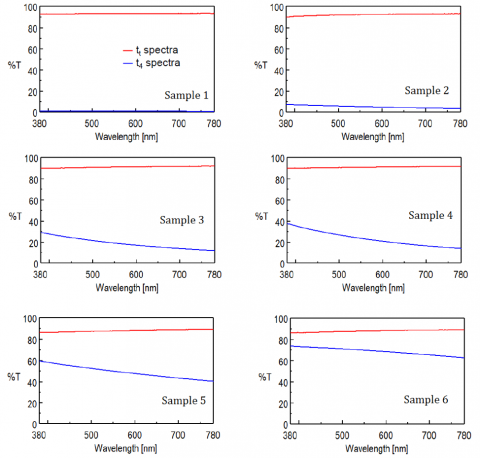
Table 1. Calculated haze values for diffuser panels.
| T3[%] | Tt[%] | T4[%] | Td[%] | Haze [%] | |
| 1 | 0.08 | 93.06 | 0.71 | 0.63 | 0.7 |
| 2 | 0.08 | 92.13 | 4.94 | 4.86 | 5.3 |
| 3 | 0.08 | 90.88 | 18.7 | 18.62 | 20.5 |
| 4 | 0.08 | 90.8 | 23.12 | 23.04 | 25.4 |
| 5 | 0.08 | 87.75 | 69.34 | 69.27 | 78.9 |
| 6 | 0.08 | 85.46 | 70.56 | 70.49 | 82.5 |
Featured Products:
-
V-730 UV-Visible Spectrophotometer
-
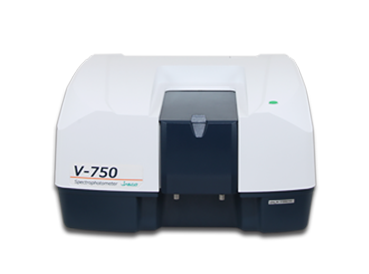
A high resolution UV-Visible double-beam spectrophotometer with single monochromator, variable SBW and PMT detector
V-750 UV-Visible Spectrophotometer
-
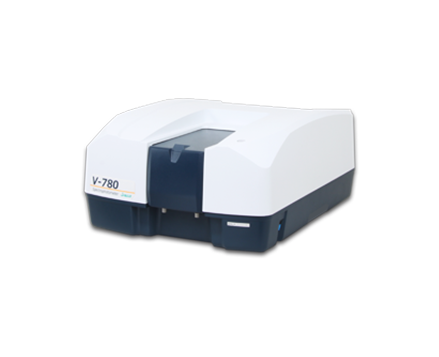
A high sensitivity UV-Visible/NIR Spectrophotometer with InGaAs detector for wavelengths up to1600nm
V-780 UV-Visible/NIR Spectrophotometer

Haze Measurement using a UV-Visible Spectrophotometer
Introduction

UV-Vis Spectrophotometer
The haze measurement of a transparent sample describes the amount of light scattered when light passes through a transparent sample. The lower the haze measurement value, the higher the clarity of the sample indicating fewer impurities.
In this application note, the haze measurement value and total light transmittance in a sample of diffuser panels is reported, using measurement methods based on JIS, ISO, and ASTM standard procedures.

Experimental
Figure 1 illustrates how the total transmittance (Tt), sample diffusion rate (T4), and scattering rate (T3) are obtained using an integrating sphere. The baseline spectrum is obtained using a white diffuse reference plate (1) and the light scattered by the instrument itself is measured (T3) in order to calibrate the spectrophotometer.

The total light transmittance and sample diffusion of the sample is then measured and the haze value is calculated by the ratio of the two spectra:

| Measurement Conditions | |||
| Bandwidth | 5 nm | Scan Speed | 400 nm/min |
| Response | 0.24 sec | Data Interval | 1 nm |
| Light Source | D65 | View Angle | 2° |
Results
The spectrum of the total light transmittance (τt) and the sample diffusion rate (τ4) of the quartz diffuser plates are shown in Figure 2. The calculated haze values are shown in Table 1. The spectra and haze values clearly indicate a difference in samples 3, 4, 5, and 6.

Table 1. Calculated haze values for diffuser panels.
| T3[%] | Tt[%] | T4[%] | Td[%] | Haze [%] | |
| 1 | 0.08 | 93.06 | 0.71 | 0.63 | 0.7 |
| 2 | 0.08 | 92.13 | 4.94 | 4.86 | 5.3 |
| 3 | 0.08 | 90.88 | 18.7 | 18.62 | 20.5 |
| 4 | 0.08 | 90.8 | 23.12 | 23.04 | 25.4 |
| 5 | 0.08 | 87.75 | 69.34 | 69.27 | 78.9 |
| 6 | 0.08 | 85.46 | 70.56 | 70.49 | 82.5 |
Keywords
190-UV-0042, V-650/660/670, UV-Visible/NIR, Haze, Diffuse transmittance, Materials, Integrating sphere

 Download This Application
Download This Application